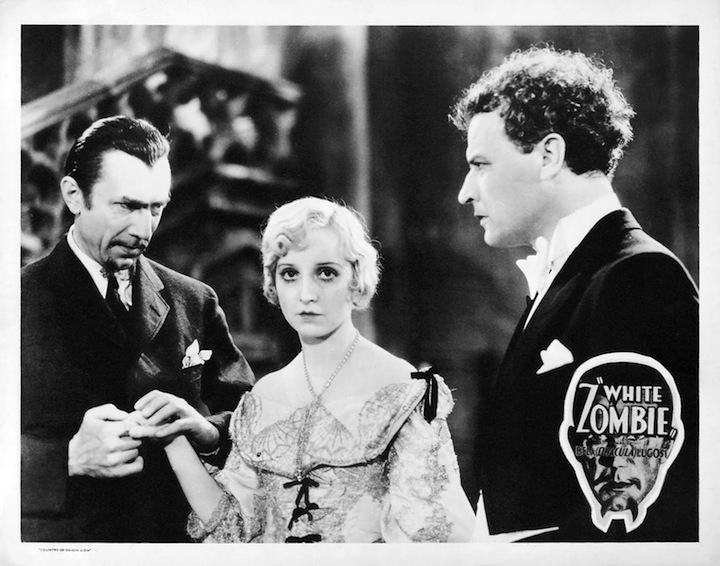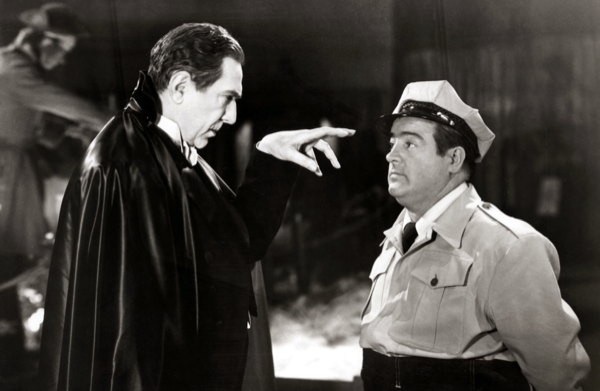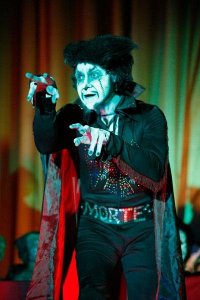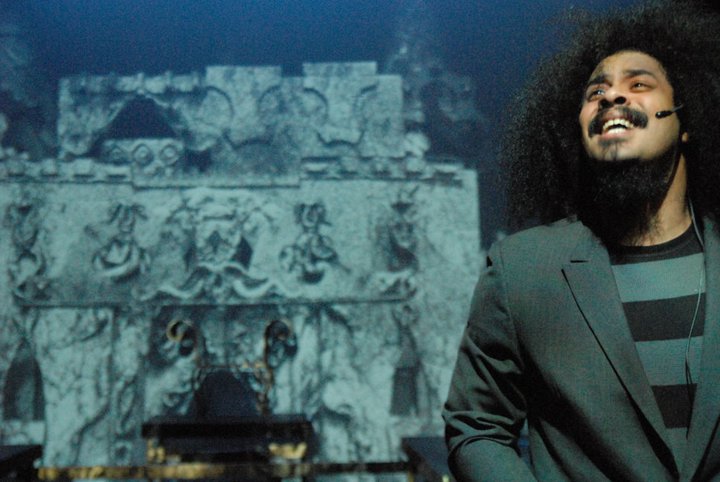By Lucas Hardwick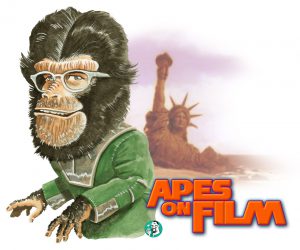
Contributing Writer
Welcome to Apes on Film! This column exists to scratch your retro-film-in-high-definition itch. We’ll be reviewing new releases of vintage cinema and television on disc of all genres, finding gems and letting you know the skinny on what to avoid. Here at Apes on Film, our aim is to uncover the best in retro film. As we dig for artifacts, we’ll do our best not to bury our reputation. What will we find out here? Our destiny.
 CREEPING HORROR – 1933 – 1946
CREEPING HORROR – 1933 – 1946
4 out of 5 Bananas
Starring: Lionel Atwill, Randolph Scott, Charlie Ruggles, Rondo Hatton, Bela Lugosi, Dick Foran, Robert Lowery, Virginia Grey, Fay Helm, Leo Carrillo
Director: A. Edward Sutherland, Ford Beebe, George Waggner, Jean Yarbrough
Rated: Not rated
Studio: Eureka Entertainment
Region: BBFC: 12
BRD Release Date: April 17, 2023
Audio Formats: English: LPCM 2.0 Mono (48kHz, 24-bit)
Video Codec: Codec: MPEG-4 AVC
Resolution: 1080p
Aspect Ratio: 1.37:1
Run Time: 263 minutes total runtime
CLICK HERE TO ORDER
MURDERS IN THE ZOO – 1933
You can turn on your TV to just about any channel today and hand pick your brand of depravity. Almost anything goes on basic cable and network TV isn’t far behind. But there was a time in entertainment when torture and wild animals was as shocking as the first bare ass on NYPD Blue. Of course, I’m talking about those rascally edge lords of pre-code Hollywood, where filmmakers worked relatively regulation-free in a cinematic Wild West.
And in the case of Eureka Entertainment’s CREEPING HORROR collection, the first film in the lineup is the pre-code 1933 film MURDERS IN THE ZOO, which opens with a man being hog-tied and having his mouth sewn shut for making out with the wife of wealthy big-game hunter Eric Gorman (Lionel Atwill). And when Gorman isn’t grinding an axe over other men making eyes at his wife Evelyn (Kathleen Burke), he’s in the business of being the sole curator of a struggling zoo, bringing in his big game specimens for exhibition.
business of being the sole curator of a struggling zoo, bringing in his big game specimens for exhibition.
The zoo’s press agent Peter Yates (Charlie Ruggles) collaborates with Gorman to host a fundraising dinner where the local money can come and dine in the zoo surrounded by exhibits. The zoo’s new highly venomous mamba specimen is all the talk and works out conveniently for Gorman as he plots the murder of his wife’s latest fling, rich guy Roger Hewitt (John Lodge). Gorman secretly acquires the deadly mamba venom from zoo veterinarian Dr. Jack Woodford (Randolph Scott), and when Roger turns up dead at the fundraiser with a leg full of mamba venom, not a soul is the wiser; that is until Evelyn discovers the weird snakehead device in her husband’s office that leads Dr. Woodford to perform some astute detective work. It’s not long before everyone starts putting the pieces together about poor Mr. Hewitt’s demise.
The film clips along at a feverish pace, never really giving anyone time to ponder for very long about exactly how Gorman used his little snakehead device to kill Hewitt. Instead, MURDERS IN THE ZOO is more occupied with being wrapped up in its frantic narrative that will have hearts racing up to the feature’s final moments. The film’s pre-code tendencies also amp up the excitement, subverting any ideas we have about the quaintness of early filmmaking.
Randolph Scott’s Dr. Woodford is basically the hero of the film, but he’s about as much fun as a snakebite. However, very little could ever compete with Atwill’s abusive and squirmy performance as “third rail” guy Eric Gorman.
Pre-code Hollywood films always deliver some grisly goods typically with some violating sexual tension up to and including brief nudity as well as most likely the unethical use of exotic animals. It makes for some damn thrilling entertainment and not necessarily for what’s happening narratively, but in a “hold my beer” kind of way. The titillation of pre-code movies is in the unsavory things that would eventually come to be censored. If you cut out the horrific opening, Gorman’s lack of “Me Too” awareness, and the alligator feeding that drives the plot along, you don’t have much of a movie left.
MURDERS IN THE ZOO has just enough of a humorous streak to keep things light, and just enough shock to feel dangerous, making for easy thrills that let you go on about your day.
NIGHT MONSTER – 1942
Italian giallo films are some of the very best instances of the old red herring trope. When they’re done right, you’ll never guess who the killer is, and the killer is almost always the person sitting in a wheelchair for the entire film. Throw in a lecherous, hulking limo driver, a creepy butler, a ghoulish gatekeeper, and a Middle Eastern mystic who can telepathically teleport dead bodies from the other side of the world, and the line between Universal horror and Italian giallo gets a little fuzzy. The difference here in Ford Beebe’s 1942 film NIGHT MONSTER is, it’s learned doctors who are turning up dead instead of pretty Italian girls.
NIGHT MONSTER packs a gothic estate full of colorful characters in what essentially amounts to a remake of the 1932 Warner Bros. horror classic DOCTOR X. In the film, the affluent and paraplegic Curt Ingston (Ralph Morgan) invites his team of doctors to his home to demonstrate a new exotic treatment that could allow him to walk once again. These unconventional methods are performed by the mysterious Agar Singh (Nils Asther)  who falls into a trance and conjures a skeleton from a grave on the far side of the world. Singh suggests Ingston could employ these methods to eventually cure his paralysis.
who falls into a trance and conjures a skeleton from a grave on the far side of the world. Singh suggests Ingston could employ these methods to eventually cure his paralysis.
In the meantime, Ingston’s nutty sister Margaret (Fay Helm) is seeing blood all over the house and blaming it all on unpleasant housekeeper Miss Judd (Doris Lloyd) while dead bodies are showing up at the nearby swamp; the scenario is not a good look for butler Rolf (Bela Lugosi) who spends most of his time slinking around the house and being nasty to the rest of the staff.
NIGHT MONSTER is a story that can’t help but be disjointed as it becomes a victim of its own convoluted plot. It may be hard to follow, but it’s important to trust your instincts—in spite of what it tries to tell you, you’ve likely guessed the killer by the second act. But regardless of its numerous characters and rambling structure, the film is soberly self-aware, making it the most fascinating and entertaining film in this set.
Bela Lugosi and Lionel Atwill get top billing, but don’t be fooled—their roles are mostly incidental and only briefly divert our suspicions. The cast overall seems charged with an angry, paranoid energy that goes against the fact that we’ve already guessed the killer at this point, but they fulfill their roles implicitly, holding true to the film’s spirit of mystery.
Films like this are always a pleasant surprise, and being one of the lesser Universal horror films, there’s no time like the present for audiences to discover or rediscover NIGHT MONSTER in all its deranged glory.
HORROR ISLAND – 1941
The old saying goes that a one-legged man knows the shortest distance between two places, and it’s peg-legged Tobias Clump (Leo Carrillo) who is the key to the fastest way between sailor Bill Martin (Dick Foran) and a twenty-million-dollar treasure in George Waggner’s 194 film HORROR ISLAND.
Clump is rescued from drowning by Martin and his business partner “Stuff” Oliver (Fuzzy Knight) after being shoved into the ocean by a man known as The Phantom (Foy Van Dolsen) who’s been lurking about the local docks. Clump is in possession of a portion of a map that possibly leads to a hidden fortune that once belonged to notorious buccaneer Sir Henry Morgan. And Morgan’s treasure just so happens to be located in a castle on an island inherited by Martin, called “Morgan’s Island.”
After rejecting a twenty thousand dollar offer from his cousin George (John Eldredge) to purchase the island, Martin exercises his entrepreneurial spirit and concocts a plan to assemble an ensemble of treasure hunters at fifty bucks a pop to buy in to venture to the island and uncover Morgan’s riches. The Phantom man in tow becomes public enemy number one as bodies begin piling up upon arrival to Martin’s abandoned gothic abode.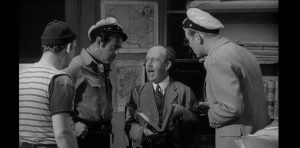
The story culminates into the typical “old dark house” scenario as cast members begin dropping like flies leaving those who remain scratching their heads. Obviously The Phantom is the prime suspect, but no one really gets more than a glimpse of him. Just because a guy wants to run around in a black cloak and wide-brimmed hat may just make him stylish. It’s important to take stock of everyone’s reasons for being there in the first place: dirty pirate treasure. A number of red herrings throw Martin and company off the trail; including a sleepwalking professor and peg-leg tracks out in the yard that divert murderous blame to other members of the group.
HORROR ISLAND is certainly an exciting film, especially executed so efficiently within a brisk sixty-minute window, but the excitement falls tepid as reactions to dead bodies are consistently met with about as much concern as someone might have to finding a dead mouse. The lack of fright from the characters don’t exactly instill much fear in the rest of us murder mongers.
The big reveal comes as a bit of a surprise, but at that point, we’re no longer worried about anyone, and we’re just glad to be closing in on that sixty-minute mark.
Writers Maurice Tombragel and Victor McLeod inject a good amount of humor into the film, imbuing the narrative with a sense of farce that plays to the actors’ chemistries but there is almost no foreboding presence about the film. People are murdered and everyone goes about the business at hand.
HORROR ISLAND is no-pressure, light-hearted fun that borrows horror tropes to do almost nothing with them. While enjoyable and energetic, audiences shouldn’t expect anything more than sub-par Abbott and Costello business.
HOUSE OF HORRORS – 1946
Eureka’s final film in the CREEPING HOROR set is arguably the most ambitious in terms of attempting to stake a claim amongst the likes of DRACULA and FRANKENSTEIN. Jean Yarbrough’s 1946 feature film HOUSE OF HORRORS sets up Rondo Hatton as The Creeper in what was supposed to be the character’s introduction for a series of films to fall in line with Universal’s legacy horror figures.
In the film, sculptor Marcel De Lange (Martin Kosleck) discovers Hatton’s Creeper floating in a river as the artist contemplates suicide upon having his recent expressionistic work coldly rejected by the big-time newspaper art critic F. Holmes Harmon (Alan Napier). De Lange laments to The Creeper about being at the mercy of critics like Harmon and expresses his desire to see the man be forced off this mortal coil. De Lange is also so taken with Hatton’s strangely striking visage, and commits to creating a larger than life-sized sculpt of the afflicted man. And as any murderous art subject is wont to do, The Creeper returns the favor by exacting De Lange’s death wishes on the local art critics that have made the lives of artists like himself  and advertising creator Steve Morrow’s (Robert Lowery) a living hell.
and advertising creator Steve Morrow’s (Robert Lowery) a living hell.
From here, the film is basically a whodunit that the audience knows the answer to. Viewers will likely find the most thrills in the suspense of “who’s next” along with the thoughtful, confounding question of the muddled motives of The Creeper himself. Not to mention, Hatton cuts an alarming form, stealing every scene he’s in.
Sassy newspaper reporter Joan Medford (Virginia Grey) goes about sticking her nose in a lot of business to not only try to help out her pals De Lange and Morrow, but eventually to aid in apprehending the creeping killer who’s running all over town snapping the spines of art critics and pretty girls.
The film ends as troubling as one might expect. But the real tragedy is that The Creeper never had the chance to make his way in the Universal horror realm. Hatton previously portrayed The Creeper in Universal’s Sherlock Holmes picture THE PEARL OF DEATH (1944). It wasn’t until his appearance in HOUSE OF HORRORS that The Creeper was the star of the show. Hatton appeared as The Creeper once more in THE BRUTE MAN, released the same year as HOUSE OF HORRORS, but sadly passed away due to complications of his disfiguring condition, known as acromegaly, before either film saw the light of a projector bulb.
Hatton’s Creeper is certainly something to behold on screen. The laconic character’s stoic, stalking disposition is quite chilling, but the use of deformity as genre entertainment raises ethical concerns that today’s more sensitive audiences would find disapproving.
Screenwriter George Bricker moves the story along at an efficient pace, peppering the film’s vibrant characters with refreshingly florid, crackling dialogue, especially when compared to other Universal B-pictures of the day. After reporter Joan Medford defends her pal, artist Steve Morrow, F. Holmes Harmon rather eloquently and unpleasantly expresses his distaste for the man’s work while also berating the rest of society: “Unfortunately, the general public’s appreciation of art is limited to billboards and magazine covers. The morons wallow in a sea of girls, girls, unbelievably beautiful and well-proportioned girls.” We may cut The Creeper a little slack for offing this guy.
HOUSE OF HORRORS is also atypical of the early B-horror film because it seems to suggest a subtext regarding the contentious relationship between artists and their critics. The entire narrative is predicated on F. Holmes Harmon rejecting De Lange’s art. From there, art critics become the antagonist’s antagonist. It’s hard to call anyone besides Joan Medford a protagonist. Artist Steve Morrow seems to fit that role too along with the obligatory police detective, but Morrow is really only collaterally involved. The main characters, De Lange and The Creeper, have no morally redeemable motives whatsoever. The film is truly a psychotic, anti-hero story; De Lange is just a different version of a mad scientist with a “monster” at his disposal to help exact his every whim.
redeemable motives whatsoever. The film is truly a psychotic, anti-hero story; De Lange is just a different version of a mad scientist with a “monster” at his disposal to help exact his every whim.
This film is a fascinating glimpse at a new Universal legacy character that never really had the chance to fully explore its potential. HOUSE OF HORRORS works as a different kind of horror tale that borrows a template from those that came before, but also attempts something even more chilling than the usual monster film. The Creeper is genuinely terrifying beyond his malformed appearance. He’s something that cannot be reasoned with and arguably one of the most menacing creations of the period.
Eureka Entertainment presents these four creepy classics on high-definition Blu-Ray in its two-disc CREEPING HORROR collection. Special features include trailers for each film and a limited-edition booklet with writing by Craig Ian Mann and Jon Towlson. Film author Stephen Jones and author/critic Kim Newman provide commentaries for NIGHT MONSTER and HOUSE OF HORRORS. And film historians Kevin Lyons and Jonathan Rigby offer commentaries for MURDERS IN THE ZOO and HORROR ISLAND. The set is packaged in a limited-edition slipcover.
Universal sought relentlessly to recapture the spirit of horror so prevalent in films like FRANKENSTEIN and DRACULA in the years following those films, and did so with varying degrees of success. Eureka’s CREEPING HORROR collection is a refreshing sampling of films that endure within the Universal horror legacy.
When he’s not working as a Sasquatch stand-in for sleazy European films, Lucas Hardwick spends time writing film essays and reviews for We Belong Dead and Screem magazines. Lucas also enjoys writing horror shorts and has earned Quarterfinalist status in the Killer Shorts and HorrOrigins screenwriting contests. You can find Lucas’ shorts on Coverfly.
















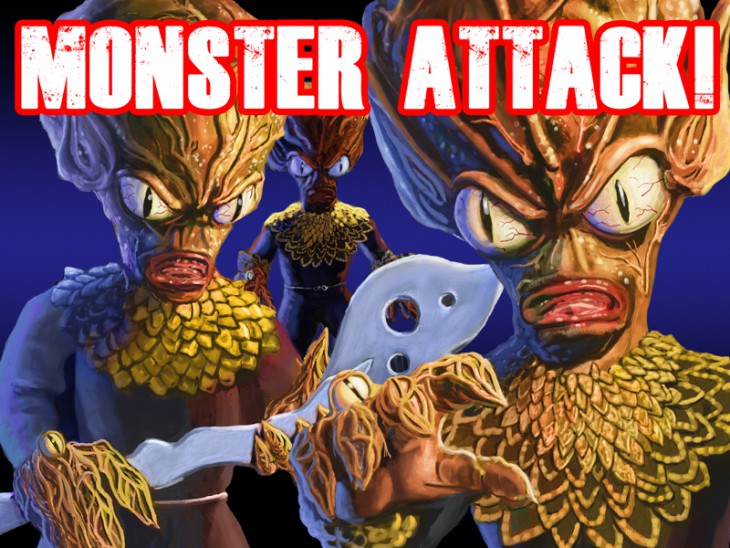
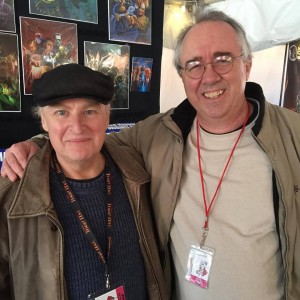
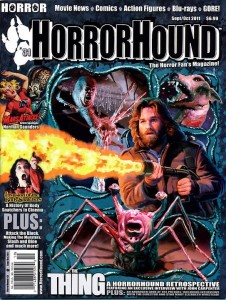
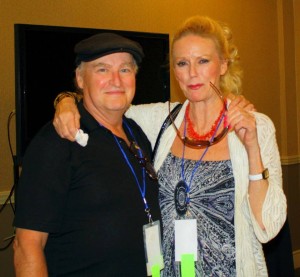
 just before Christmas.
just before Christmas. podcast. Vampires have always been favorites as well. I am a huge fan of the Hammer films featuring
podcast. Vampires have always been favorites as well. I am a huge fan of the Hammer films featuring  of attention?
of attention? Can you tell us a little about some of your favorite “monster kid” memories?
Can you tell us a little about some of your favorite “monster kid” memories? GUIDE every week and looking to see what “Monster Movies” were going to come on that weekend. The other was going to the newsstand and seeing the latest copy of
GUIDE every week and looking to see what “Monster Movies” were going to come on that weekend. The other was going to the newsstand and seeing the latest copy of  M: Classic films have a lot of dedicated people working for them – writers, directors, actors, technicians, etc. I think that quality is what makes people return to them. With modern horror films, the ones that say something new (
M: Classic films have a lot of dedicated people working for them – writers, directors, actors, technicians, etc. I think that quality is what makes people return to them. With modern horror films, the ones that say something new ( hands off approach to filmmaking? And what is your favorite “old-school” special effect that you think should be used more often in modern film-making?
hands off approach to filmmaking? And what is your favorite “old-school” special effect that you think should be used more often in modern film-making? Mark, it’s no secret that your artistic resume and portfolio is quite prolific with your art spanning the covers of SCREEM MAGAZINE; HORRORHOUND MAGAZINE; LITTLE SHOPPE OF HORRORS; MAD SCIENTIST MAGAZINE (and so many more!); your illustrations being used for Warner Brothers Blu-ray releases; and your Vincent Price magazine and book covers leading you to becoming an officially licensed artist through the Vincent Price estate. Can you tell our readers what drew you to your art and why this particular subject matter? And who would you say is your greatest inspiration/influence and why?
Mark, it’s no secret that your artistic resume and portfolio is quite prolific with your art spanning the covers of SCREEM MAGAZINE; HORRORHOUND MAGAZINE; LITTLE SHOPPE OF HORRORS; MAD SCIENTIST MAGAZINE (and so many more!); your illustrations being used for Warner Brothers Blu-ray releases; and your Vincent Price magazine and book covers leading you to becoming an officially licensed artist through the Vincent Price estate. Can you tell our readers what drew you to your art and why this particular subject matter? And who would you say is your greatest inspiration/influence and why?
 We hear that you were going to initiate a Patreon for subscribers and funding for Project iRadio. Can you tell us a little about that effort?
We hear that you were going to initiate a Patreon for subscribers and funding for Project iRadio. Can you tell us a little about that effort?









